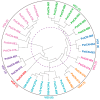Virulence Characterization of Puccinia striiformis f. sp. tritici in China in 2020 Using Wheat Yr Single-Gene Lines
- PMID: 40558959
- PMCID: PMC12194282
- DOI: 10.3390/jof11060447
Virulence Characterization of Puccinia striiformis f. sp. tritici in China in 2020 Using Wheat Yr Single-Gene Lines
Abstract
Wheat stripe (yellow) rust, caused by the fungus Puccinia striiformis f. sp. tritici (Pst), is one of the most threatening wheat diseases worldwide. Monitoring the virulence of Pst population is essential for managing wheat stripe rust. In this study, 18 wheat Yr single-gene lines were used to identify the virulence patterns of 67 isolates collected from 13 provinces in China in 2020, from which 33 Pst races were identified. The frequency of virulence to different Yr genes varied from 1.49% to 97.01%, with 4.48% to Yr1, 26.87% to Yr6, 11.94% to Yr7, 95.52% to Yr8, 19.40% to Yr9, 11.94% to Yr17, 2.99% to Yr24, 35.82% to Yr27, 38.81% to Yr43, 97.01% to Yr44, 8.96% to YrSP, 1.49% to Yr85, 95.52% to YrExp2, and 7.46% to Yr76. None of the isolates were virulent to Yr5, Yr10, Yr15, and Yr32. Among the 33 races, PstCN-062 (with virulence to Yr8, Yr44, and YrExp2) and PstCN-001 (with virulence to Yr8, Yr43, Yr44, and YrExp2) were the prevalent races, with frequencies of 28.36% and 11.94%, respectively. These results provide valuable information for breeding resistant wheat cultivars for controlling stripe rust.
Keywords: Triticum aestivum; pathogen; race identification; resistance genes; stripe rust; virulence diversity.
Conflict of interest statement
The authors declare no conflicts of interest.
Figures





Similar articles
-
Virulence Characterization of International Collections of the Wheat Stripe Rust Pathogen, Puccinia striiformis f. sp. tritici.Plant Dis. 2013 Mar;97(3):379-386. doi: 10.1094/PDIS-01-12-0078-RE. Plant Dis. 2013. PMID: 30722363
-
Inheritance and Linkage of Virulence Genes in Chinese Predominant Race CYR32 of the Wheat Stripe Rust Pathogen Puccinia striiformis f. sp. tritici.Front Plant Sci. 2018 Feb 8;9:120. doi: 10.3389/fpls.2018.00120. eCollection 2018. Front Plant Sci. 2018. PMID: 29472940 Free PMC article.
-
Virulence Characterization of Wheat Stripe Rust Fungus Puccinia striiformis f. sp. tritici in Ethiopia and Evaluation of Ethiopian Wheat Germplasm for Resistance to Races of the Pathogen from Ethiopia and the United States.Plant Dis. 2017 Jan;101(1):73-80. doi: 10.1094/PDIS-03-16-0371-RE. Epub 2016 Sep 28. Plant Dis. 2017. PMID: 30682307
-
Virulence Characterization of Puccinia striiformis f. sp. tritici Using a New Set of Yr Single-Gene Line Differentials in the United States in 2010.Plant Dis. 2014 Nov;98(11):1534-1542. doi: 10.1094/PDIS-01-14-0071-RE. Plant Dis. 2014. PMID: 30699782
-
Wheat stripe (yellow) rust caused by Puccinia striiformis f. sp. tritici.Mol Plant Pathol. 2014 Jun;15(5):433-46. doi: 10.1111/mpp.12116. Mol Plant Pathol. 2014. PMID: 24373199 Free PMC article. Review.
References
-
- Wellings C.R. Global status of stripe rust: A review of historical and current threats. Euphytica. 2011;179:129–141. doi: 10.1007/s10681-011-0360-y. - DOI
-
- Kang Z.S., Wang X.J., Zhao J., Tang C.L., Huang L.L. Advances in research of pathogenicity and virulence variation of the wheat stripe rust fungus Puccinia striiformis f. sp. tritici. Sci. Agric. Sin. 2015;48:3439–3453.
-
- Awais M., Ma J., Chen W., Zhang B., Turakulov K.S., Li L., Egamberdieva D., Karimjonovich M.S., Kang Z., Zhao J. Molecular genotyping revealed the gene flow of Puccinia striiformis f. sp. tritici clonal lineage from Uzbekistan of Central Asia to Xinjiang of China. Phytopathol. Res. 2025;7:2. doi: 10.1186/s42483-024-00290-5. - DOI
-
- Huang L., Chen X., Dong Y., Huang W., Ma H., Zhang H., Xu Y., Wang J. Dynamic Analysis of Regional Wheat Stripe Rust Environmental Suitability in China. Remote Sens. 2023;15:2021. doi: 10.3390/rs15082021. - DOI
-
- Zhao J., Kang Z. Fighting wheat rusts in China: A look back and into the future. Phytopathol. Res. 2023;5:6. doi: 10.1186/s42483-023-00159-z. - DOI
Grants and funding
LinkOut - more resources
Full Text Sources

